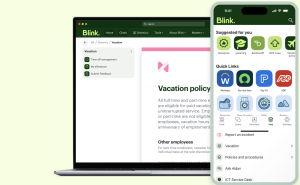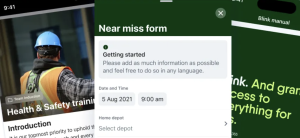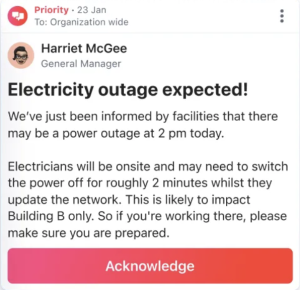When the world went office-less in 2020, the big winner was undoubtedly Zoom.
In 2019, revenue of this small firm that allowed video-calls was an uninspiring $330 million – hosting around 10 million meetings per year. By 2021 however, it was hosting 300 million ‘per day’ and today sits on revenues of $4.5 billion pa. It was officially the fastest growing brand of 2020 and almost instantly, it’s become part of office life and a way of keeping touch with an increasingly remote workforce.
But even before the pandemic, there was already a huge communication-gap brewing between employers and employees – between managers and those who are principally ‘frontline’ workers – everyone from bus drivers, salespeople, retail staff and the like.
According to the Workday Frontline Workforce Study, around 82% of all workers in the US and 2.7 billion global workers are part of the frontline workforce – but most of these often feel disconnected and unable to keep up to date on important work-related information.
There’s one company, however, that has quietly been filling this vacuum – so-called ‘SuperApp’ company Blink.
While it doesn’t attract the same sort of headlines as Zoom, it is arguably doing just as important a job, and while Zoom’s growth is flatlining, Blink is enjoying phenomenal growth – with US growth of 159% for its fiscal year 2023, concluding in February 2024.
It’s growth that makes it one of the fastest growing ‘employee experience’ companies, and it now boasts 300 frontline-first companies including Domino’s, Tonkotsu, Saint Luke’s Hospital, Elara Caring and Falck Ambulance.
The emergence of the ‘SuperApp’


What make Blink different is its intention to bridge the technology gap between desk-less and desk-based employees with an app that gives employees a single entry point into everything they need to support them in their working life – from communications, productivity tools, benefits and people and process information [hence its ‘Super-App’ definition].
It is headed by a Briton – Sean Nolan – the former founder of UK creative agency, Tomorrow Communications. It was through running this in the 2010s as a largely distributed business, that he realised there was a need to give staff what he called a “sense of belonging.”
With no real experience in technology, the genesis of Blink was created.
It was launched in 2019 and, by getting what he calls a “lucky break” with 24,000 employee-strong bus company, Stagecoach, the concept was able to be proved.
Now he’s permanently based in the US, and is on a mission to give HR the tools they need to maintain communication and build engagement with their desk-less staff.
The need for better engagement of frontline staff
“I remember meeting the CIO of Stagecoach at an IDC Future of Work event,” he recalls, talking exclusively to TLNT.
“She told me their frontline staff felt disconnected, and that the MD was looking for a solution. Literally, I was there at 9am the next morning, presenting to him, and we got the gig.”
According to Nolan, around 50% of US workers are the more realistic proportion of desk-less workers, and he argues “very few organizations have worked out how to manage this well.”
He adds: “We came up with the super-app concept because we felt communications alone wasn’t enough to add value to people, or make them want to engage with an app that is essentially on people own personal phones. That’s why we’ve integrated pay and benefits, and holiday taking elements and shift-swap functionality that really brings engagement up.”


He continues: “Communications from companies is traditionally very fragmented. Blink aims to address this, but also make it something that’s organic and which gives people a reason to return. So while there can be push communications from the CEO, a lot of clients use us for more localised communications from managers.”
He adds: “There’s a bottom-up element too, where anyone can post ideas, share things, or suggest solutions to problems. At Stagecoach, for instance, a driver asked why he stops at a long-since closed supermarket. This knowledge was captured, and the route was changed.”
Apps work where intranets don’t
In 2023, Gartner recognized Blink as a leading software provider in its annual Market Guide for Employee Communications Application where it said SuperApps were shaping this market’s future.
More recently, in Spring 2024, Blink also ranked a Leader in the G2 Grid® for Best Employee Engagement Software.
According to Nolan, the basis for this is that while other platforms do exist – such as Slack (the office intranet provider), they suffer from low engagement.
“What employees want is something that helps them rather than being dominated by unstructured communications,” he says. “People don’t often want to put workplace apps on their personal phones unless they really see a benefit of it. We say that we take the friction away from workplaces being able to generate their own cultures. Large companies using us can feel smaller, and more intertwined.”
Workplaces’ failure could be Blink’s gain
The failure of larger enterprise social networks to really engage staff can be seen by Meta announcing it would be starting the process of shutting down its enterprise communications business, Workplace.
The business once had big ambitions to be a major player in enterprise communication and productivity, but its loss is set to be Nolan’s gain, with Blink’s chief confirming that he is in talks with many of Meta’s customers about transferring over to Blink.
“We can do better by workers,” he promises, “and there is a huge opportunity here.”
Blink is still relatively small in the US (headcount-wise), but according to Nolan, the 30 people currently employed should at least double in the next 18 months.
“We get approached by people looking to buy us all the time – which says something about the perceived need for better communications between employers and frontline workers,” says Nolan.
“We’re still small and the problems we want to solve are still big. So, at the moment we are concentrating on our own growth. The desk-less space business is still huge, and there is still so much opportunity to take more friction away from people’s lives.”
He concludes: “There’s still things that haven’t been built for desk-less workers, and we want to be the first people to do it.”
